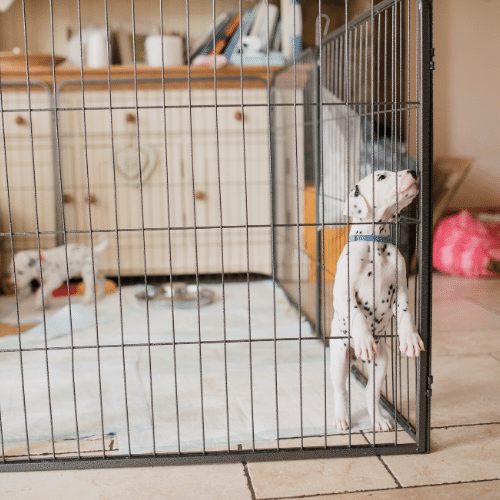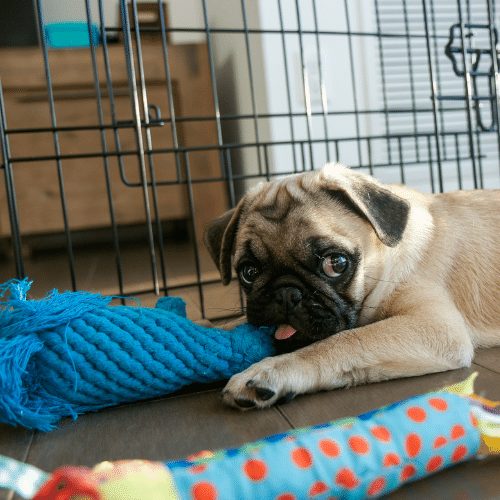Crate Training or Pen Training?
March 30, 2021 2021-08-23 11:20So you are getting a new puppy – congratulations! In preparing for the arrival, you probably wonder about a lot of training and lifestyle questions. One of the most common puppy questions I get as a dog trainer is whether the pup should be in a crate or puppy playpen.
The quick answer is that ideally you get your puppy used to being in both a crate and a playpen.
Today we will look at when to decide for one or both options, and how to best train your pup to stay in an enclosed space.
Table of Contents

Should a puppy be trained to stay in a crate or playpen?
If you have a puppy – especially a very young puppy – it is crucial that he learns to be comfortable in an enclosed space. It is simply not possible to safely give a small pup the run of your house. Not only will he have potty accidents, but he will also chew toxic plants, swallow and gnaw on everything you want him to not touch (such as batteries, shoes, furniture, walls …). Many puppies get seriously ill because their owners allowed them too much freedom, too soon.
In order to keep your puppy safe when you cannot supervise him, he absolutely needs to be confined to some area. This is usually a crate or puppy pen.
In general, crates work well during the night. You want your puppy to sleep then (not potter around) and confining him to a small space will make it likely that he wakes you up if he needs to go potty.
During the day however, a puppy pen works best. You can put toys and chew items in there as well as a water bowl, and your puppy can spend several hours in his playpen without constant supervision.

Advantages of pen training
First of all, puppies do not actually need to be “pen trained”. You simply put them into the pen and if they have plenty of toys and chews in there they will probably be happy.
Your puppy most likely spent his days in a pen before ever coming to live with you. No breeder or rescue gives a litter of puppies the run of the house. Instead, he and his littermates were likely confined in a play pen already.
The pen allows you to give your puppy plenty of enrichment. Puppies can walk around, run, roll and wrestle with their toys in an exercise pen. If you put enriching equipment such as a wobble board in there, your pup can even practice his balance and coordination skills while he is in the pen.
Though big enough to allow your puppy to move around, play pens are still small enough to discourage puppies from peeing in there. If at all possible, you should refrain from putting pee pads into the pen and instead take your puppy out to potty on a regular schedule. That way he will learn quickly that peeing inside is a no-no.
Advantages of crate training
Crate training is great for nighttime. What makes playpens great during the day (that puppies have space to run around and play) can make them frustrating at night. If you want to sleep but your puppy takes lap after lap in his exercise pen, you will not be amused!
Crates provide a small and confined space for your pup. If you put him in a crate at night, there is not much else to do other than sleep. Crate training often helps even very young puppies sleep through the night very quickly and even discourages them from waking you up to pee.
In addition to the help with sleeping at night, crate training comes in handy later in your dog’s life. If you plan to attend any dog sports events such as agility in the future, your dog will need to stay in a crate while waiting his turn at the show.
Should your dog ever have to stay at a veterinary clinic overnight, he will also need to be crated there. Never having been crated before could add considerably to his stress and anxiety.
Crating is also the safest way to transport dogs in a car.
While playpens are mostly used at home, being crate-trained will be useful for your dog in a variety of different situations throughout his life!
Training your dog to stay in a crate and/or exercise pen
The best way to teach your dog to calmly stay in a crate or pen is to start when he is young and practice daily in small time increments. If you put your puppy into a crate for 5 hours during the day, it is practically guaranteed that he will whine and cry. Instead, begin with very short time increments and gradually work your way up to longer durations.
Whether you put your dog into a crate or pen, he will do best if he just had some activity, exercise or enrichment. Puppies cry because most of them are bored and didn’t have an outlet for their energy. If they just went on a long walk or did a training session with their owner, they are much more likely to settle quickly and quietly.

The bottom line
There are advantages for both crate training and pen training your puppy. Playpens will come in handy if you want your puppy to stay in a safe place during the day. Crates provide a small and secure space during the night. In addition, getting yout young puppy used to a crate will prepare him if he ever has to stay in a crate later in life – such as at a vet office, at a dog show or during a car ride.
Most owners do best with combining crate training and pen training – this way you get the best of both worlds and your puppy gets used to a variety of different forms of containment at home. If you do not want to make two bigger purchases, check local thrift stores – dog crates often get donated and can be picked up for cheap there!

